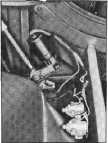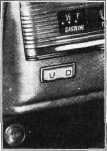1942 - 1947 CHEVROLET SHOP MANUAL
Section 1 Body
|
|
|||||
|
1-36
|
|||||
|
|
|||||
|
difficult to service.
Window regulators and controls are confined in the space between the
upholstery and the outside door panel and, while it is possible in
some cases to apply oil by drops to a long wire leading to the
operating mechanism, it is not a practical procedure, as extreme care
must be taken to keep the oil from contacting the trim on the inside
of the door. Easy access to the working parts may be made by removing
the trim.
Over-Lubrication
Excessive lubrication
of body parts usually causes more complaints than lack of lubrication.
If a soft, dark grease is applied to a door lock bolt or a dovetail
wedgeplate on the exposed face of the door, a slight brush across this
soft grease may ruin a gown and spoil the entire evening for the owner
and others. Too much lubrication applied to exposed parts serves no
good purpose. It is not only a waste of material but is a contribution
to serious complaints.
Lubricate only where
squeaks develop, or where conditions indicate that the addition of
lubricant is desirable for easier operation of individual units or
points.
CABRIOLET
The cabriolet model
passenger car contains many body items of the same general design and
construction as used on the closed cars. Service procedures on these
items are the same as on closed models. Primarily, the folding top and
its mechanism, the windshield and quarter windows, and the genuine
leather upholstery used on the cabriolet represents the major items of
different design and construction.
The folding top is
power operated. The operating mechanism comprises two reversible
electric motors, one for each side of the top, operated through a
magnetic switch unit located on the floor pan just to the left of the
car centerline under the rear seat cushion.
|
Each motor is
mounted at about a 45 degree angle, drive end down, into a gear
reduction case. The bottom of this case is pinned through a yoke
mounted to the floor pan, allowing the entire unit to float as
necessary to conform with the control arm movement when lowering or
raising the top.
|
 |
|||
|
Fig. 80-Cabriolet
Left Top Motor and Magnetic Switch Unit
|
|||||
|
To Lower the Top
1.
STOP THE CAR-Ignition
switch must be ON.
2. Release
the three toggle latches where the top
front bow joins the top of the
windshield. Push the top
up slightly at the front end.
3. Push
the control button "D" on the left end of
the instrument panel and hold it
in until the top is
completely lowered.
The procedure for
raising the top is the reverse of
the foregoing. BE SURE ALL THREE TOGGLE LATCHES ARE SECURELY
FASTENED BEFORE DRIVING THE CAR.
NOTE-If the top is
to be left in the down position, assemble the top bow strap and
fasten it securely at the loop on the shelf behind the top of the rear
seat. Following this INSTALL THE TOP BOOT. This protects the top
material against dirt and damage.
Care of the Fabric Top
Always be sure the top
is thoroughly dry before lowering and folding it in the down position.
Folding the top while still damp may cause mildew and unsightly
wrinkles.
Avoid getting grease
or oil spots on the material. Such substances when mixed with ordinary
traffic grime are particularly difficult to remove without leaving
evidence of cleaning.
When the top is to be
down in the folded position for any length of time, the top boot
should be installed to keep the top clean and prevent accumulation
of dust and dirt in the folds of the material which may result in
streaks and stains.
Luggage, golf clubs,
etc., should not be placed on the top when folded down. Loose articles
of this type not only interfere with the operation of the top, but may
cause a chafing action and result in serious damage to the fabric.
Top Boot
Top boots are custom
made to fit each individual cabriolet body. Due to this the top boot
should not
|
|||||
 |
A push button type
switch, located at the left end of the instrument panel, Fig. 79,
provides the control for lowering or raising the top. The top can be
lowered or raised only when the ignition switch is turned ON.
The electric motors
are located one in each rear quarter of the body,
concealed behind the
|
||||
|
quarter trim and arm rest, Fig. 80.
|
|||||
|
Fig. 79-Cabriolet Top
Control Button
|
|||||
|
|
|||||